Charaka Shareera Sthana 1st Chapter Katidha purushiyam Shareeram
1st chapter of Charaka Shareera sthana deals on understanding of constitution of the Body. The chapter name is Katidha purushiyam Shareeram.
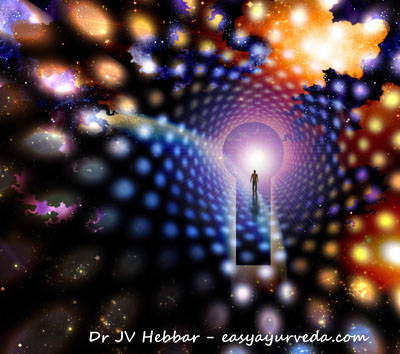
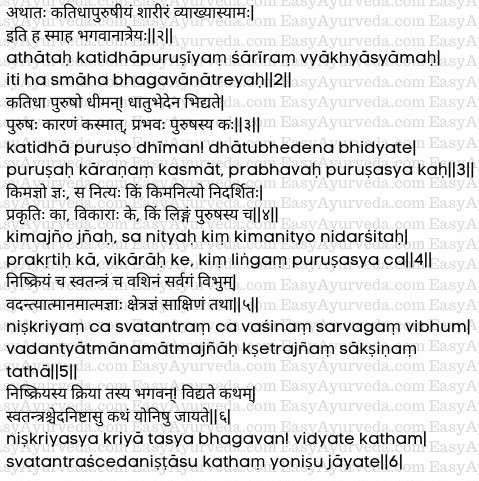
Table of Contents
Empirical Soul
We shall now explore the chapter dealing with the several of the “Empirical Soul” etc, conducive to the understanding of the constitution of the body. Thus said Lord Atreya [1-2]
Read – Prakriti – Dosha Body Type Features As Per Master Charaka
Queries of Agnivesha
What are the divisions of the ‘Empirical Soul’ according to the division of Dhatus (elements)?
Why is the “Empirical Soul’ considered to be the cause of the body?
What is origin of “Empirical Soul’’?
Is he wise (perceivable) or ignorant (non-perceivable)? Is he eternal or ephemeral?
What is constitution? What are deformities / derivatives? What are ten symptoms (characteristics) of the soul?
Those who have expertise in spiritual science describe the “Empirical Soul” as
- devoid of action
- independent
- having self control
- absolutely free
- all pervasive
- knower of the body and
- a witness / spectator
When is the “Empirical Soul” devoid of action; how does action emanate from him?
When he is independent why does he take origin from (among the) undesired wombs / undesirable species?
Read – Atma – The Soul: Types, Life Cycle
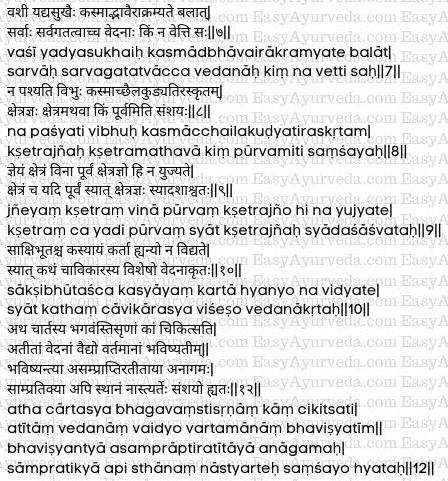
If the soul is under self control (has gained control over all his senses) why is he forcibly enveloped by (influenced by) the emotions? (It means to tell ‘If he is absolutely free, how is He overpowered with miserable ideals?’)
If he is everywhere, is He not aware of all miseries of everyone?
If He is omnipresent, how does He not visualize things interrupted by (beyond) the hills and walls?
Which comes first- the body or the knower of the body (soul)? There is always confusion about this.
Read – Importance Of Soul In Perception Of Knowledge: Atma Jnana
Kshetra (body) is the one which needs to be known. If there is no knower then it is no use telling ‘kshetrajna (the one who resides in the kshetra i.e. soul)’. This is because if there is kshetra only then there will be a knower of kshetra. If we first accept the existence of kshetra, we might have to accept that kshetrajna (soul) is anitya (impermanent, transient).
If there doesn’t exist another doer to do the actions apart from atma (soul) then to what and whom is the soul ‘the witness / observer’ of (then whom does the soul observe or form a witness to)? It means to tell that when someone does the actions, the other person who observes these actions would be considered as witness or observer. But we call the soul as observer / witness of the actions. If there is no other doer of action other than the soul, then whom does the soul observe?
The soul is regarded as ‘devoid of deformities’, then how does this soul experience ‘happiness and grief’?
Out of the three types of pain / miseries of a patient, i.e. teh past one, the present one and the future one, which one should the physician treat?
The future pains / miseries are not in existence (not yet been manifested) therefore there is no question of treating them.
The past pains / miseries do not exist and will not recur.
The pains / miseries of the present time (which exist right now) are momentary and don’t behave in a fixed way and so in the absence of continuity, it is not amenable to any treatment.
So the above mentioned doubt always exists i.e. ‘which pains / miseries should the physician treat?’
Read – Adhyatmika Gunas – Qualities Related To Soul As Per Ayurveda
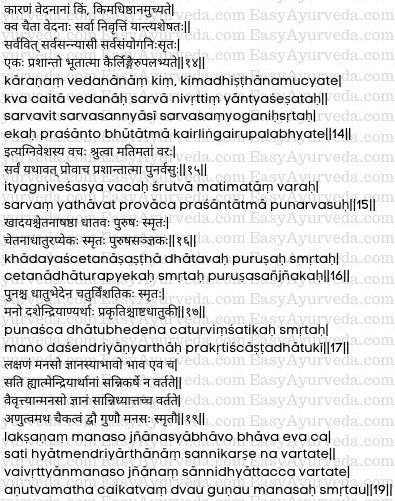
What are the causative factors of miseries (diseases)?
What are sites of their manifestation?
Where do all these miseries sub- merge after their cure
What are the signs which help in the recognition of the “Empirical Soul” which is omnipresent, all –renouncing, devoid of all contacts, only one and tranquil?
Master Punarvasu, the most learned one and wise among the other lot after hearing patiently all the questions asked by Agnivesha gave suitable replies to all the queries.
Different concepts about Purusha
Purusha comprises six Dhatus (elements), i.e.
- five Maha bhutas (in their subtle form) i.e. ether, wind, fire, water and earthand
- soul / consciousness
Even the element of consciousness alone constitutes Purusha. [16]
Another concept of Purusha comprising twenty-four factors
Purusha is again said to be made up of 24 dhatus / tattvas (entities). They are –
Manas – mind – 1
Indriyas – sense organs and organs of action (motor organs) together – 10 in number. They are –
- 5 jnanendriyas i.e. sense organs – eyes, ears, nose, tongue and skin
- 5 karmendriyas i.e. motor organs – i.e. organs of speech, hands, legs (feet), anus and penis
Indriyartha – objects of sense organs – 5 in number i.e. vision / sight, sound, smell, taste and touch
Prakriti – 8 in number –
- Avyakta – primordial element
- Mahat – intellect
- Ahamkara – ego
- Panchamahabhuta – 5 elements of nature – earth, wind, water, fire, ether [17]
Read – Panchamahabhuta: Application, Areas of Utility in Ayurveda treatment
Proof of Existence of Mind and its attributes
The two main characteristics of the mind are –
- Gaining the knowledge of something (understanding something)
- Not gaining the knowledge of something (not understanding something)
These two are opposite characteristics but both belong to the mind. This is the reason why one understands something at a given point of time and sometimes he doesn’t understand something else. This proves the existence of the mind as a separate sense organ. One doesn’t get the knowledge of anything when the soul, sense organs and sense objects are associated. This is because the mind is absent in the association. So when there is no contact of the mind with the soul, sense organs and sense objects one do not understand things. On the other hand one can understand anything when the mind gets associated with the soul, sense organs and sense objects.
Below mentioned are the qualities of the mind –
- Minuteness / Atomicity and
- Oneness [18-19]
Read – Mind – Qualities, Functions, Doshas As Per Ayurveda
Objects of Mind
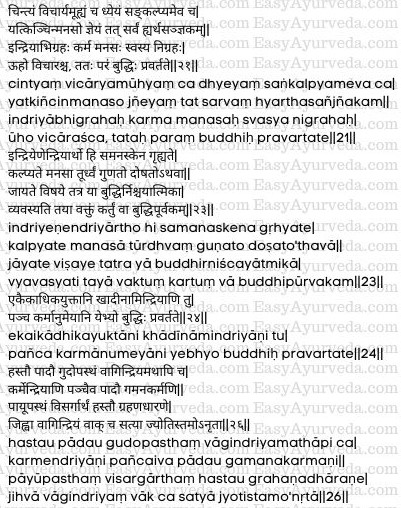
Below mentioned are the subjects of the mind –
- To think – what to do and what not and focusing on those things which need thought process
- To analyze / consideration – example, ‘I would be benefitted if I do this, I would be at loss if I do this. etc
- To guess / imagination / hypothesis – example, to think ‘this would be the end result of any action taking’
- To meditate – upon whatever needs to be meditated upon / giving attention or pondering upon
- Determination / willful decision – example, taking a decision after properly analyzing every fragment of the action in terms of qualities and faults and determining ‘since this is beneficial it shall be considered’
- Anything which can be known or understood by the mind (without the help of the sense organs) are considered as subject matters of the mind.
Functions of the mind
- Controlling the sense organs
- Controlling self / self restraint
- Imagining / making hypothesis and
- Analysis / consideration
Beyond that flourishes the domain of intellect. [20-21]
Read – 16 Factors To Watch For A Healthy Mind And Body
Process of perception
When the mind gets associated with the sense organs, the sense organs would perceive their respective sense objects. The mind later would analyze the objects and decide and ascertain whether they are advantageous (should be accepted) or disadvantageous (should be rejected).
The intellect which determines (the specific properties of the object impel a (sane) individual to speak or act intelligently. [22-23]
Composition of sense-organs
The five sense faculties are made up of all the five Mahabhutas but among the five elements of nature only one element will be predominant in each sense organ. Fire element is predominant in the eye, water element in the tongue, earth element in nose, ether in ears and wind element in the skin. They are inferred from their five respective actions which serve as agents for the manifestation of the intellect. [24]
Read – Earth Element – Qualities, Functions, Diseases, Treatment
Motor- organs and their functions
Motor organs are five in number i.e. hands, feet, anus, phallus and the organ of speech (tongue). Feet are useful in locomotion, anus and phallus for voiding and hands for collection and holding. The tongue represents the organ of speech. Speech is of two kinds, viz, true and false. The former (true speech) can be compared to light which illuminates the worldly life and the life after death and the latter (false speech) to darkness which creates confusion. [25-26]
Attributes of five Mahabhutas
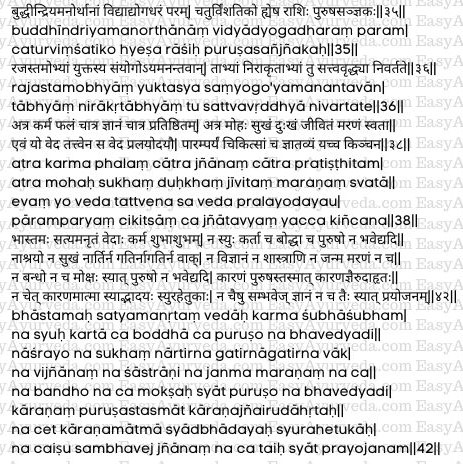
The five Mahabutas are Akasha (ether), vayu (wind), Agni (fire), Jala (water) and Prthvi (earth). Their attributes are sound, touch, vision, taste and smell respectively. [27]
Mahabhutas and their attributes
Of the five Mahabutas mentioned above, the first one (i.e Akasha) has only one attribute. The number of attributes in the succeeding Mahabutas goes on increasing successively. The attributes of the preceding ones are added to the succeeding ones respectively. [28]
Characteristics of Mahabhutas
| Sl No | Mahabhuta (Name of the element of nature) | Characteristic feature | Meaning |
| 1 | Prithvi – Earth | Kharatva | Roughness |
| 2 | Jala – Water | Dravatva | Liquidity |
| 3 | Vayu – Wind / Air | Chalatva | Mobility |
| 4 | Tejas – Fire | Ushnatva | Heat |
| 5 | Akasha – Ether | Apratighata | Not being obstructed |
All these characteristics are perceived by the tactile sense organ / sense organ of touch (skin). Just like the tactile sense organ i.e. skin perceives touch sensation, it also perceives ‘absence of touch’. [29-30]
The qualities of the subtle and minute bhutas (sound, touch, sight etc sensory objects / perceptions) residing in the body will also be identified and known as the qualities of the mahabhutas (gross elements). [31- 1]
The sound etc qualities which are perceived by the sense organs and are also the subjects of the sense organs are called as ‘arthas’ i.e. sense objects / objects perceivable by the sense organs. [31?]
Read – Qualities Of Five Basic Elements (Vishishta Gunas) – Classification, Uses
Perceptive Faculty
The wisdom or intellect is associated with the sense organs for perception of sensory objects and also to understand them. The intellect gets the name of the sense organ with which it is associated at the time of perception of that particular sense object.
Examples,
Chakshusha Buddhi – the intellect associated with the eye – helps in perception of visual objects
Shravana Buddhi – the intellect associated with the ear, – helps in perception of sound
Spaarshana Buddhi – the intellect associated with the skin – helps in perception of touch
Raasana Buddhi – the intellect associated with the tongue – helps in perception of taste
Ghrana Buddhi – the intellect associated with nose – helps in perception of smell
Manasa Buddhi – the intellect associated with mind – helps in perception of the knowledge coming through various senses touching with the mind – responsible for mental perceptions like anxiety, sorrow etc
Why different types of the above-mentioned intellects exist?
Perceptual faculties / intellects are of several types. This is because the actions are of different kinds and the objects of sense organs are also of many kinds. The intellects depends on these factors i.e. various kinds of actions and sense objects. All these types of intellect are manifested due to its association with soul, sense organs, and mind and sense objects. This means to tell that any type of knowledge is obtained only when all these faculties are associated in a close knitted loop.
Examples for ‘manifestation of intellect in different forms’
The sound of click is produced by the friction between finger and thumb, just like the clap is produced when the hands (palms) collide with each other, and just like the tunes are produced from the association of guitar, its string and the nails (of the fingers). All these sounds are totally different from each other. Just like this due to the different types of combinations of the soul, mind, sense organs and the objects of sense organs – different kinds of intellect are produced / manifested. Just like the sounds are formed due to the combinations of what gives orgin to them, the intellect also forms due to the combination and association of soul, mind, sense organs and sense objects. If these are not associated the intellect is not manifested. [32-34]
Read – Manasika Doshas – Satva, Rajas, Tamas As Per Ayurveda
Purusha as co-ordinator
Rasi Purusha (Individual formed by collective amalgamation of 24 elements) – We should consider the soul to be the one who has adorned the combination of (associated with the combination of) intellect, senses (sense organs), mind and teh objects of the sense organs. Therefore Avyakta (soul) is the co-ordinator par-excellence of perceptual faculty, sense organs, mind and the objects of sense. The combination of the above mentioned (Verses 17-35) twenty four elements is known as Purusha. Being associated with 24 elements, the soul is called as chaturvimshati purusha or rashi purusha. [35]
Contact of Purusha because of Gunas
The contact of Purusha with 24 elements continues as long as he is influenced by Rajas and Tamas. The moment he gets rid of Rajas and Tamas he is freed from contacts by virtue of the dominance of Sattva. [36]
Knowledge of Purusha
It is in this combination of 24 elements which is known as Purusha, action, fruit of action, knowledge, ignorance, happiness, misery, life, death and ownership are established. One, who dually knows this, knows the life, death, continuity of the body i.e. the sequence of the cycle of birth and death with rebirth followed by death, treatment (Physical and spiritual) of diseases manifested in the current life time and also the methods to attain freedom from the vicious cycle of life and death and attain salvation and all other knowable objects. [37-38]
Read – Purusha: Definition, Types, Characteristic Features
Purusha as a causative factor
The arguments in support of existence of the soul – If the doer, the one who experiences and the one who knows everything i.e. Purusha were not there, talent / knowledge and ignorance or light and darkness, truth or falsehood, the Vedas, good or bad action, could not exist. If the existence of purusha is not believed then the abode of the soul i.e. this body too would not have existed. There would also be no happiness, misery, movement / the soul leaving the body (salvation), immobility / rebirth, speech, knowledge, scriptures, birth, death, bondage or salvation. So Purusha is recognised as a cause (of creation) by those well versed in the theory of causality.
If Purusha is not recognised as a cause, the above would be left without a cause. There would be no consciousness, nor there any utility of theirs. [39-42]
Read – Karma, Saguna, Ativahika Purusha – Definition, Composition
Baseless talks
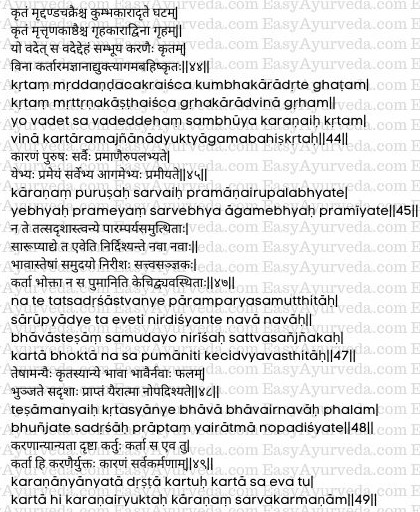
This pot has been made by the combination of mud, stick and wheel without the involvement of the potter.
This house has been constructed by the combination of mud, straw, beams, bamboo and sticks without the involvement of an engineer.
Only a person who can tell these things would tell that the body has been created by the combination of 23 elements without the involvement and association of the soul. It is only an ignorant person devoid of rational outlook and scriptural knowledge who can make such statements. [43-44]
Causality of Purusha
All the sources of knowledge including scriptural which serve as instrument for knowledge of various kinds establish the causality of Purusha. [45]
Read – Influence Of Ayurveda in Darshanas: Analysis, Explanation
Nastika- opinions contradicting the eternity of the Soul
There are no permanent entities as such. No object which exists is permanent. They are formed new and afresh after the previously existing objects which appear similar to them have been destroyed. This means to tell that they are produced afresh each time. They appear to be the same objects because of similarity of type and form between them. It is the people and schools of thought who believe in these concepts who tell that the living beings are devoid of soul. It is the living beings and not the soul as such is doers and enjoyers of action. This view is held by some schools of thought (Buddhists etc). [46-47]
Defects in the above said theory
According to them (i.e the pronouncers of the above theory, viz. Buddhists who do not believe in the existence of a permanent entity as Soul) the results of action performed by one would be enjoyed by some other similar (momentary entities) [48]
Causality of Purusha emphasised
The doer of action, for example a sculptor / engineer might use different equipment’s to accomplish his action, but the doer is the same. He is an efficient cause of all actions by the virtue of his possession and command of the various instruments. Just like this, the soul is only one, he performs many actions through different instruments i.e. organs of the body. So the doer is only one but he can accomplish various actions and become the cause of them when he is accomplished with many instruments of actions and has command over them. [49]
Additional Proofs for causality of Purusha
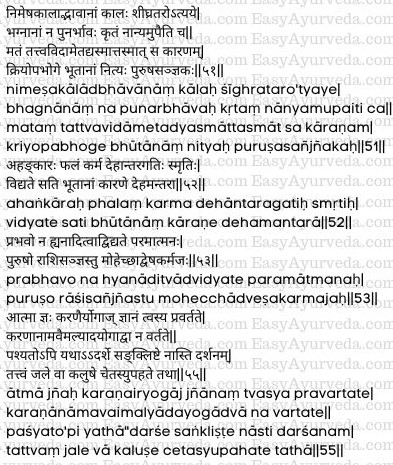
Physical elements get destroyed at a rate faster than the twinkling of an eye; those destroyed do not come back to their original form again and the results of the deeds (like Yajna) of one individual are not enjoyed by another individual. The learned ones are therefore of the view that there is a permanent entity known as Purusha who is causative factor for the action entity known as enjoyment of its fruits. [50-51]
Proof of the existence of soul
In living beings, a factor other than the body (i.e the soul) is responsible for ego, the fruits of action in the form of pleasure or pain, engagement in action, transmigration i.e. the soul moving from one body to the other and memory of the individual. [52]
Paramatman and Rashi Purusha
As the supreme Soul doesn’t have any beginning, so there is nothing which can give birth to the soul (no birth as such can be ascribed to him). Of course the empirical Soul (Purusha) who represents the combination of 24 elements is born out of trance, desire, hatred / enviousness and action. [53]
Read – Paramatma – The Greater Soul: Difference Between Jivatma And Ishwara
Process of perception
The empirical Soul is endowed with the power of perception and has knowledge of everything. It perceives things when it gets associated with the sense organs (sense faculties, mind and intellect). If these instruments of perception are either absent (not in association with the Empirical Soul) or impeded, then there will be no perception. One cannot get the real reflected picture of an image from a mirror which is covered with dirt or from water which is muddy. Similar is the case when the mind etc. gets afflicted. [54-55]
Co-ordination of various factors for perception
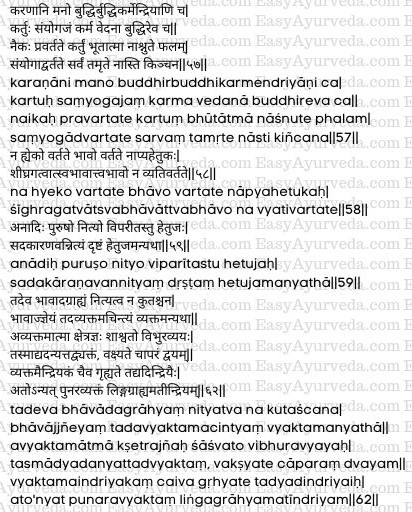
The instruments of knowledge are mind, intellect, sense organs and organs of action. Their association with the Doer (Empirical Soul) results in action, sensations like pleasure and pain and knowledge / understanding. The empirical Soul alone (in the absence of instruments of knowledge) does neither initiate action nor enjoy the fruit of action. Combination of all these factors is responsible for the manifestation of all actions. If the association between the soul and the other elements doesn’t occur no actions take place. [56-57]
Read – How Knowledge Is Gained Through Sense Organs?
Empirical Soul and Manifestations
The empirical Soul not alone but accompanied with instruments of knowledge is responsible for the manifestation of things that exist. Things do not manifest without their causal factors. Then we get a question ‘do void / non-existence of things’ too have causes? The answer is no. The process of decay on the other hand being too quick in succession does not need any cause as such. [58]
Absolute Soul and Empirical Soul
Absolute Soul doesn’t have a beginning (origin) and therefore is eternal. The Empirical Soul (i.e the combination of 24 elements) being caused by something (i.e. causes like ignorance, desire, hatred, action, righteousness and non-righteousness etc) is not so i.e it has a beginning and is ephemeral.
All that exist without cause is eternal. This means to tell that anything which can be known in all the time lines (past, present and future) and do not have any causes which produce them is eternal. Anything produced from a cause is ephemeral i.e. anything which exists and which is produced by other causes is emphemeral. [59]
The absolute Soul cannot be perceived by anything, for eternity is not caused by anything. So the absolute Soul is unmanifested and imperceptible. The manifested creation is of course otherwise i.e. those things which are known through their manifestation i.e. the purusha made up of 24 elements is emphereal, manifested and perceived.
The absolute Soul is unmanifested, knower of creation, eternal, universal and indestructible. The manifested creation (Empirical Soul) is of course otherwise. Another way of distinguishing manifested things from the unmanifested one is that the former can be perceived by sense faculties. The latter is transcendental in nature and is imperceptible; it can only be inferred (rather than received) i.e. is beyond the perception of senses. [60-62]
Read – Relation Between Doshas, Sense Organs And Perception
Twenty- four Elements
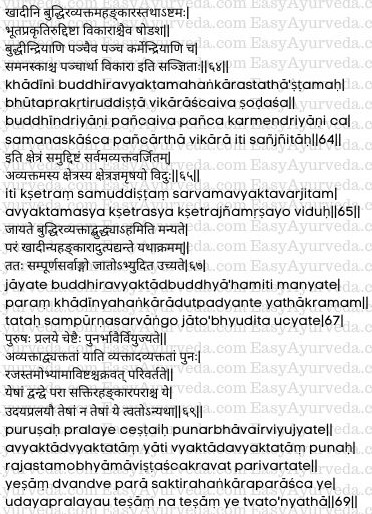
Eight Prakritis – The five subtle elements (Sabdanmatra, Sparsatanmatra, Rupatanmatra, Rasatanmatra and Gandhatanmatra), Buddhi (intellect), Avyakta (Prakrti or nature) and Ahamkara (ego) are the eight sources of creation.
Sixteen Vikritis – Transformations (vikara) are sixteen in number. They are – five sense faculties, five motor faculties, mind and five mahabhutas i.e. elements of nature. [63-64]
Read – Prakriti – Ayurveda Body Types, Importance In Treatment And Remedies
Ksetra and Ksetrajna
All these elements taken together, except the unmanifested one (avyakta) is known as Ksetra i.e corpus. The unmanifested one is known as Ksetrajna (knower of the corpus). [65]
Process of creation
The intellect (buddhi) originates from Avyakta (unmanifested, soul). Ego (Ahamkara) gets manifested from intellect (buddhi). From Ego the subtle forms of five Mahabhutas i.e. tanmatras get manifested i.e. akasha etc. Later the vikaras i.e. 16 transformations are formed in order. The empirical Soul thus manifested in its entirety is regarded as born. [66-67]
Read – Influence Of Ayurveda in Darshanas: Analysis, Explanation
Process of dissolution
During the time of destruction of the age, the Purusha (soul) again dissociates himself from all the manifestations meant for his enjoyment, viz, Buddhi etc. The five elements get absorbed into their subtle forms i.e. tanmatras. The tanmatras and eleven senses (5 sense organs, 5 motor organs and mind) get absorbed into the ego. The ego gets dissolved into the intellect and the intellect gets absorbed into the avyakta (the unmanifested). The universe is created from the unmanifested stage to the manifested one during creation, and then absorbed back again from the manifested stage to the unmanifested one during total annihilation.
Those who are attached to rajas and Tamas and those who are egoistic repeatedly undergo the process and vicious cycle of birth and death; others do not. Those indulged in and attached to the dualties like desire, hatred, selfishness, intoxication, lust, anger etc and those who are enveloped by egoism will be born and will also die i.e. they are put into the cycle of life and death. Those who are free from raja and tama qualities and also from egoism and erroneous knowledge will not be afflicted by the vicious cycle of life and death (would attain salvation). [67-69]
Read – Personality Types And Features Based On Satva, Rajas, Tamas
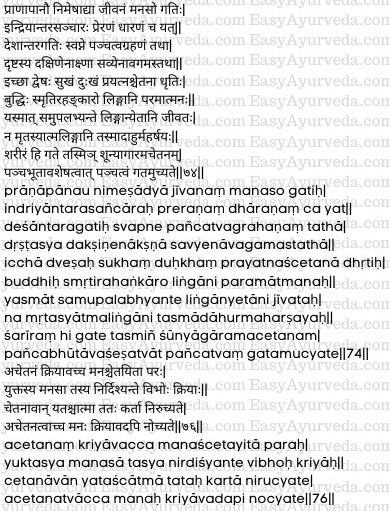
Proofs for the existence of absolute soul
The following is the proof of the existence of the absolute soul:
Inspiration and expiration
Twinkling / blinking of the eye
Life
Mental perception (e.g arriving at a far distant place like Pataliputra in imagination)
Shift from one object of sense organ to another (e.g shift from visual perception to tactual perception)
Mobility and stability of mind
Journey to another country in dreams
Anticipation of death
Knowledge of something visualised in the right eye by the left eye
Desire, hatred, happiness, misery, effort, consciousness, stability, intellect, memory and ego
All these are signs of the living person. These signs are not available in a dead body. So they are considered to be the proof for the existence of the absolute Soul. When that soul departs, the body becomes vacant and is deprived of consciousness; only the five Mahabhutas remain. So a dead person is said to have attained the state of five Mahabhutas (Panchatva). [70-74]
Read – Ayu – Meaning, Explanation, Types Of Lifespan

Mind and Soul
The mind is devoid of consciousness but has action. It is the soul which lends the consciousness to the mind. When the soul gets associated with the mind, the actions done by the mind residing in the soul (in association with the soul) will be considered as the actions done by the soul. The soul has consciousness. Therefore, it is said to be the agent of action (one who does / is responsible for all action). Even though it possesses of action the mind is said to be devoid of action since it is devoid of consciousness. [75-76]
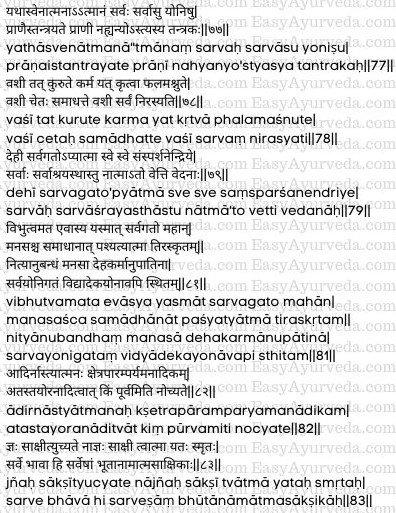
Responsibility for transmigration
The soul will take itself from itself into different species (as life element in different species of life) in accordance with the results of the actions done by self (previously). None else is responsible for the transmigration of living being from one species to another [77]
Freedom of action of the soul
The soul is absolutely free to act as he pleases. He is however obliged to enjoy the fruits of his action. He is also free to control his mind and to get rid of the results of good or bad acts of his own. [78]
Read – Cluttered Mind – Get Rid Of The Big Hurdle Between You And Success
Limitation in the power of perception of soul
Even though, soul is all pervasive his sensations are limited to the body in which he resides. He can only perceive the sensations of only that body adorned by its own sense organ of touch – skin (he perceives the sensations in the body in which he resides depending on the contact of the sense organs with their respective sense objects). His sense organs (sense organs of the body in which he resides) cannot reach the body of other living beings. This is the reason the soul cannot perceive all sensations experienced by the other bodies. [79]
Omnipresence of Soul
The soul is omnipresent because he pervades the entire universe and is great. Since he is bound inside a single body (in spite of being omnipresent) his sensory perceptions are limited (to only the body in which he resides). His field of action is limited to the body alone (though he is all pervasive and present in all bodies) because of his regular and contact with the mind which performs all the actions of that body. When the soul gradually gets the mind under its control he ran perceive things in spite of (spatial, temporal or material) those things being obstructed (beyond the wall, screen or mountain) or hidden by something else. Since the soul is constantly associated with the mind involved in all actions of the body and since he cannot see the things beyond obstructions (due to constant association with the mind) the soul should be considered to be present in only one body in spite of knowing that he is all pervasive (present in all bodies). [80-81]
Beginninglessness of Soul
The soul is beginningless and so is the process of evolution of the various elements. Thus, it is not possible to determine as to which one precedes the other. [82]
Soul as witness
It is only he who knows things can stand as a witness. The one who doesn’t know anything and the inert things like stone etc cannot become witness of anything (Things cannot be witnessed by unconscious objects like stone). So all attributes, actions etc., of Bhutas are witnessed by the Soul (who alone is knower of things). [83]
Read – Vata Dosha – Mastermind Behind All Body And Mind Activities
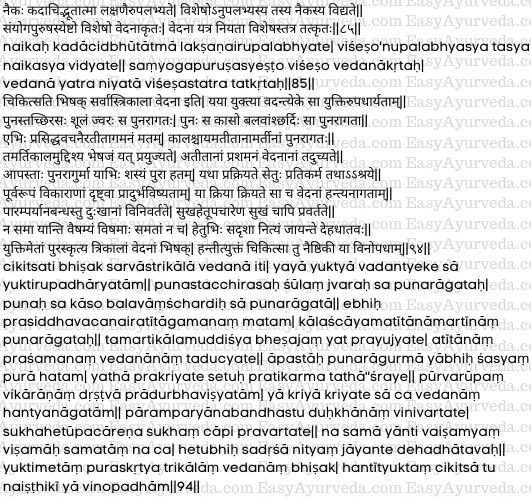
Sensations and Soul
The absolute Soul is one and only one. He is inaccessible by any signs or symptoms. Being inaccessible he has no sensation. It is only the contractual or the empirical soul who has sensations. For, these sensations do not constitute the attributes of the soul as such. They in fact arise out of the contacts (of the sense organs with their objects) [84- 85]
Treatment of diseases of past, present and future
The principle, on which the treatment of diseases pertaining to the past, present and future is based, is as follows:
Diseases of the past
Recurrence of headache, fever, cough and vomiting establishes the fact that diseases of the past do relapse. Some even say ‘the time of occurrence of the various diseases of the past’ has come once again. The therapeutic devices meant for alleviating such recurring diseases by considering the past history (of such diseases) and also the time period of their occurrence (recurrence) are considered as the ‘treatment of the diseases of the past’.
Diseases of the future
In order to prevent the flood waters from damaging the crops as they did in the past, a dam is constructed as a preventive measure. Similarly some therapeutic devices are designed and the medicines are prescribed to prevent certain diseases which are likely to attack living beings in future after having considered the premonitory symptoms of the diseases and inferring the time of occurrence of pain or disease. This treatment relates to prevention of future diseases.
Diseases of the present
The successive continuity of aliments is checked by treatment conducive to the continuity of happiness and health is established. When one takes the treatments which would establish happiness and health and also would avoid taking the causative factors which would cause diseases, the diseases are not formed. And the diseases would get destroyed by themselves. Since the person is also taking the treatments which would establish health and happiness, health and happiness too would be established. Since the etiological factors are kept away, the diseases which could occur in future too are aborted in their premature stages and hence the health will be established. Due to the constant practice of intake of the causes (things) which would establish happiness and health, the state of equilibrium of tissues and body components will be established. When this state is maintained the person would enjoy comprehensive health.
Read – Contributory Factors for a Disease – Ayurvedic View Point
The state of equilibrium of Dhatus is not disturbed nor is the imbalanced state of dhatus brought to normalcy without the involvement of some causative factors. It is the causative factors which determine the equilibrium or imbalance of the Dhatus. So a physician treats the diseases pertaining to the past, present and future. [86- 94]
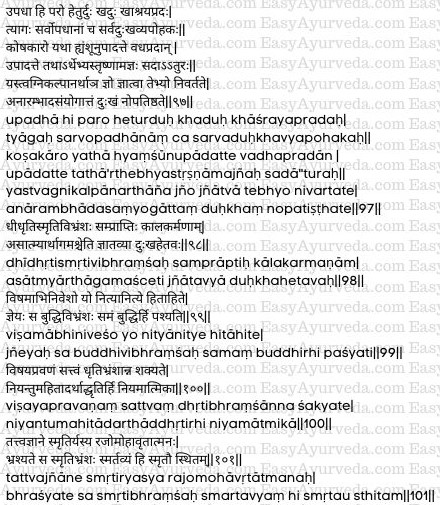
Desires and miseries
Naishtiki Chikitsa – Absolute eradication of miseries is called as nishtha. The treatments done to achieve this are called as naishtiki chikitsa. The secret of success of this treatment is ‘elimination of upadha’ i.e. an abnormal thirst called desire which keeps one attached to this materialistic world and is a cause of all miseries. Desire is the root cause of all miseries. Elimination of desire is the eradication of all miseries.
The agony of birth and death (cycle of birth and death) is the greatest misery and the body is the abode of miseries. Therefore rejection / elimination of all kinds of upadha – desires is the best method of keeping away all the diseases.
A silk-worm produces and weaves around it the silk threads which would cause its death. Similarly an ignorant person, bound with worldly miseries, provides for himself and weaves around him the ‘threads of death’ of desire arising out of the various objects. A wise person who abstains from the objects of senses, considering them as dangerous as burning fire would keep self detached from the rajas and tamas qualities. He will not indulge himself in any actions which will push him to adorn this physical body to experience the fruits of those actions i.e. he would keep himself out of desires and materialistic attachments. By not beginning the actions which would keep him attached to the desires and attachments to the materialistic world and consequently being not embedded in the physical body he will get freedom from the miseries. [94-97]
Read – Treatment For Excess Desires – Naishtiki Chikitsa
Cause of miseries
Impairment of intellect, courage (patience) and memory, advent of the maturity (of the result) of time and action and unwholesome contact with the objects of senses is considered to be the causative factors for miseries. [98]
Impairment of intellect
If something eternal is viewed as ephemeral and something harmful, and Vice Versa, this is indicative of the impairment of intellect, for the Intellect normally views things as they are. [99]
Impairment of Patience
A mind indulging in worldly enjoyments cannot be restrained from harmful objects due to the impairment of courage / patience. It is patience which can restrain the mind (from its harmful objects). [100]
Impairment of memory
If memory is impaired due to a person being overcome by Rajas and tamas, this is known as the impairment of memory. Normally memory contains everything memorable. [101]
Read – Simple Tips To Improve Memory And Fight Memory Loss
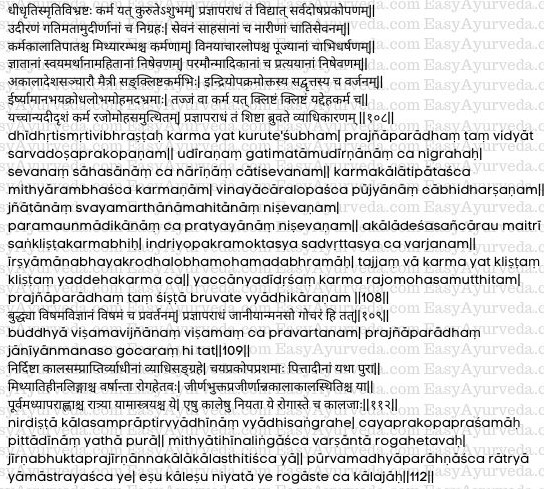
Intellectual Blashphemy
A person whose intellect, courage / patience and memory are impaired; the actions he does will be untowads and bad. These inauspicious or bad actions done by the person are called as prajnaparadha i.e. intellectual blasphemy. This intellectual blasphemy aggravates all the Doshas i.e. the physical doshas (vata, pitta and kapha) and the mental doshas (rajas and tamas).
Forcible stimulation of natural urges (when they are not manifested) and suppression of the manifested ones (which are about to get expelled), exhibition of undue strength – being over adventurous in comparison to one’s capacity / strength, over indulgence in sexual act, negligence of the time of treatment, inadequate, excessive and abnormal use of cleansing therapies – emesis, purgation, decoction enemas, oil enemas and errhines, loss of modesty and good conduct, disrespect for respectable ones, enjoyment of harmful sense objects purposefully i.e. sound, touch, sight, taste and smell, resorting to the intense causative factors which are responsible for the causative of madness, untimely movements / roaming around in restricted / prohibited places, friendship with persons of bad actions, avoidance of the healthy activates described in Sutra 10: 19:28, malice, vanity, fear, anger, greed, ignorance, intoxication and bewilderment or bad actions arising out of any of them or other physical evil acts arising out of Rajas and Tamas constitute intellectual blasphemy leading to the causation of various ailments. [102-108]
Read – Vega Dharana: Suppression of urges, types, symptoms, and management
Intellectual blasphemy and mind
Intellectual pseudo-conception (perception of improper knowledge by the intellect or information which is not ‘as it is’) and improper conduct (intellect getting indulged in actions in an improper way) represent intellectual blasphemy. (This is known as intellectual blasphemy as) alt this falls under the purview of the mind. [109]
Read – Sadvritta In Ayurveda – Code Of Conduct For Healthy Life
Temporal diseases
Ailments caused due to changes in time / seasons are already described in Sutra 17: 114. It has been explained there, how Pitta and other Doshas get accumulated, aggravated and alleviated (depending on seasonal variation). Erroneous, excessive and inadequate use / manifestation of the seasons cause dosha imbalances and cause diseases pertaining to those seasons.
Pitta, kapha and vata get aggravated during digestion, immediately after consumption of food and after complete digestion of food respectively and cause diseases in accordance to the aggravation of doshas.
Pitta, kapha and vata get aggravated due to food getting processed in abnormal time, untimely consumption of food and untimely digestion of food respectively and cause related diseases.
Kapha, Pitta and Vata get aggravated in the early hours of the morning, afternoon and evening respectively.
Kapha, Pitta and Vata get aggravated in the first, second and third parts of the night and cause diseases accordingly.
The doshas naturally get aggravated during these time periods and the diseases which get manifested during these times are called as Kalaja diseases i.e. diseases caused due to the impact of time and related dosha imbalance corresponding to that time. [110-112]
Read – Charaka Samhita Sutrasthana Chapter 1 – Quest For Longevity
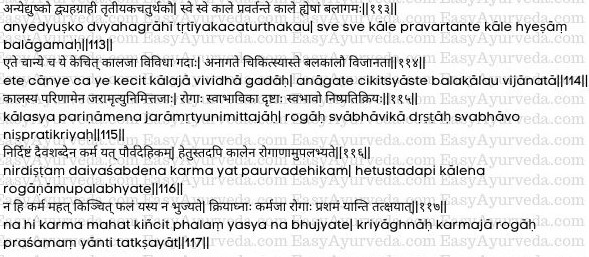
Examples of Temporal diseases
Diseases like Anyedyuska (quotidian fever which occurs at a fixed time every day), Dvyahagrahi (reverse quotidian fever), and Trtiya (tertian fever which which occurs at an interval of two days) manifest themselves at fixed hours as they get strength only at such hours. [113]
Time of treatment of temporal diseases
A physician acquainted with the strength of time of occurrence of diseases should treat this and other similar diseases prior to their actual manifestation. [114]
Natural diseases
The diseases arising out of temporal factors that bring about old age and death are to be considered as natural ones, and natural manifestations are irremediable. [115]
Actions of past life and diseases
The action performed in the previous life which is known as Daiva (fate) also constitutes causative factors for the manifestation of diseases in due course of time. [116]
Read – Daiva Vyapashraya Chikitsa – Divine Therapies of Ayurveda
Cure of karmaja Diseases
There is no major action (performed in the previous life) which does not lead to the corresponding results. Diseases arising out of such actions are not amenable to any therapeutic measures. They are cured only after the results of past action are exhausted i.e fully enjoyed [117]
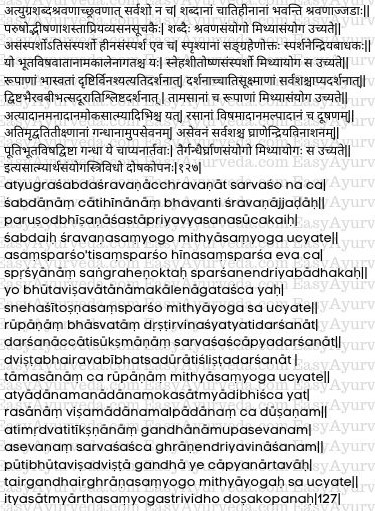
Unwholesome contacts with Senses
1. Inadequate, excessive or erroneous contact of auditory sense
The auditory sense faculty is impaired by the hearing of excessively loud sounds or low sound or not hearing the sounds at all. Hearing in excess of rough, terrifying, inauspicious or disliked sounds or sounds which indicate misery, disaster or death constitute the wrong utilization of the auditory sense organ.
2. Inadequate, excessive or erroneous contact of tactile sense
Inadequate, excessive or erroneous utilization of organ of touch i.e. skin can cause skin disorders of various kinds.
Touching the touchable things in an inadequate way (deficit exposure) or not touching them at all is considered as deficit contact of organ of touch.
Touching the touchable things in an excessive way (excessive exposure) or touching too hot or too cold things in excess is considered as excessive contact of organ of touch.
Both these decrease the strength of sense organ of touch.
Untimely contact with poisonous germs (?), Poisonous wind, and unctuous, cold and hot substances constitutes wrong –utilization of tactile sensation.
3. Inadequate, excessive or erroneous contact of visual sense
Inadequate, excessive or erroneous utilization of sense organ of visual perception i.e. eyes can cause different eye disorders.
Seeing dazzling objects in excess is considered as excessive contact of the sense organ of vision i.e. eyes.
Seeing extremely subtle and smaller things in excess or by absolute non-utilization of visual faculty is considered as deficit contact of the sense organ of vision.
Seeing undesirable, terrific, despicable, objects and objects placed at a distance or in close proximity excessively – constitutes the wrong- utilization of visual faculty. Vision is also impaired by the contact of the visual faculty with faint objects.
All these three will either make the vision weak or destroy the vision permanently.
4. Inadequate, excessive or erroneous contact of gustatory (taste) sense
Inadequate, excessive or erroneous utilization of sense organ of taste perception i.e. tongue can cause different taste related disorders.
Consuming any particular taste in excess is considered as excessive contact of the sense organ of taste – tongue.
Consuming any one, two or three tastes or not at all taking them or taking them in less quantity is considered as deficit contact of the sense organ of taste.
Taking the tastes against one’s compatibility / suitability, or taking the tastes in an erratic way i.e. sometimes consuming a taste and some other taste at some other time, or taking one taste in excess and other tastes in lesser proportions is considered as erroneous contact of sense organ of taste.
All these three are harmful for the body.
5. Inadequate, excessive or erroneous contact of olfactory (smell) sense
Inadequate, excessive or erroneous utilization of sense organ of smell perception i.e. nose can cause different smell related disorders.
Taking too mild smell or not smelling anything at all is considered as deficit contact of organ of smell.
Taking too strong / sharp smell is considered as excessive contact of organ of smell.
Inhalation of smell of putrefied objects, germs and poisonous as well as unseasonal smell constitutes wrong-utilization of olfactory faculty.
These are the three types of unwholesome contact of senses with their respective objects which aggravate the Doshas. [118-127]
Read – Improper Use Of Sense Organs: A Neglected Cause For Diseases
Unwholesomeness
A thing which is not conducive to the body is regarded as Asatmya or unwholesome. [127]
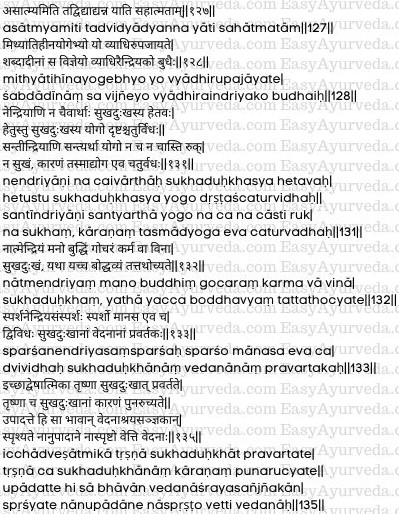
Aindriyaka diseases
When a disease is caused by wrong utilization, excessive utilization and inadequate utilization (non-utilization) of sense faculties it is known as “Aindriyaka” i.e a disease caused by the impairment of senses. [128]
These are the factors responsible for miseries. Equitable utilization (of time, intellect and objects of sense faculties) brings about happiness. This equitable utilization is difficult to attain. [129]
Read – Bad Prognosis Based On Smell, Touch, Taste, Colour And Voice
Four-fold combination
Neither the sense organs nor their objects alone can bring about happiness or miseries. Proper utilization of sense organs will lead to happiness and health. On the other hand the other three forms of utilization of sense organs i.e. erroneous, excessive or deficit / non utilization are responsible for miseries / diseases. Even if there are sense organs and their objects present, there would be neither disease nor any happiness unless there is association between the sense organs and their objects. So this combination itself constitutes a causative factor for happiness and miseries. [130-131]
Factors responsible for happiness and miseries
As a matter of fact no happiness or misery can be caused without the Soul, the sense organs, mind, intellect, and objects of sense. It is only the four-fold combination which is relevant as a causative factor of happiness and miseries (that is to say the wholesome combination is required to be adhered to and the unwholesome one to be given up for the maintenance of good health). [132]
Two types of contacts
Tactile contact and mental contact are the two types of contacts which bring about happiness and miseries. [133]
Happiness and miseries caused by Lust
Happiness and miseries bring about lust in the form of likes and dislikes respectively. Then again this lust is responsible for happiness and miseries it is lust which gathers factors, which serve as substrata for happiness and misery. Unless such factors are gathered, there will be no contact whatsoever and there can be no happiness or miseries without such contact. [134-135]
Read – Jnana and Karma Indriyas: Organs Of Sense And Function
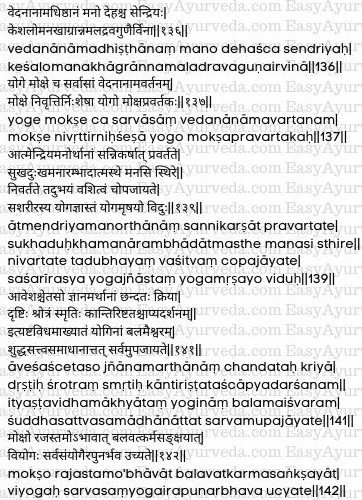
Sites of sensations
The mind and the body together with the sense organs exclusive of Kesha (hair), Loman (small hair), tip of the nail, ingested food, excreta, excretory fluids and objects of sense are the sites of manifestation of happiness and miseries. [136]
Yoga and Moksha
Recurrence of all sensation is checked through Yoga and Moksha. The absolute eradication of sensation is attained through Moksa. The Yoga is a means to attain Moksha. [137]
What is Yoga?
Happiness and miseries are felt due the contact of the Soul, the sense organs, mind and the objects of senses. Both these types of sensations disappear when the mind is concentrated and contained in the Soul because no actions happen when this happens. The person would then gain control over his mind and senses. The body and mind attain supernatural powers. The sages well versed in this science call this state as Yoga. [138-139]
Eight super-natural powers of Yogin
Entering other’s body
Thought reading
Doing things at will
Super-natural vision
Supernatural audition
Miraculous memory
Uncommon brilliance and
Invisibility when so desired – these are the eight supernatural powers attained by those practicing Yoga. All this is achieved through the purity of the mind free from Rajas and Tamas. [140-141]
Read – Health Benefits Of Yoga: Mind And Body
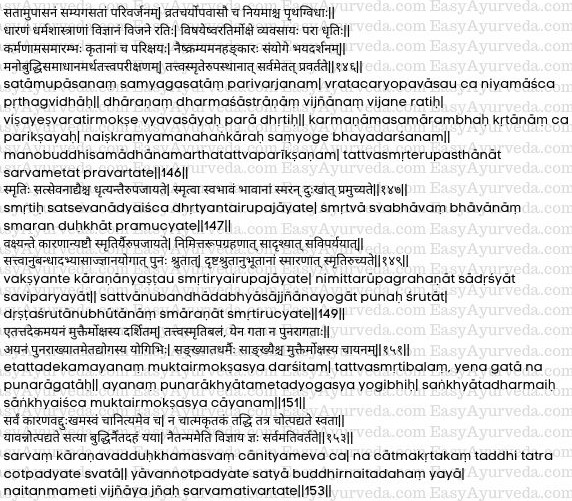
Salvation
Moksha or salvation is nothing but an absolute detachment of all contacts by virtue of the absence of Rajas and Tamas in the mind and annihilation of effects of potent past actions. This is a state after which there will be no more physical or mental contacts. [142]
Means for attainment of Moksha
The following serves as means to attainment of Moksha:
Due devotion to noble Souls
Keeping away / ending of the company of wicked / bad people
Observing sacred vows and rituals
Fasting
Pursuit of the rules of good conduct
Compliance with scriptural prescriptions
Scriptural knowledge
Liking for lonely living
Detachment from the objects of sense
Striving for moksha (Salvation)
Absolute mental control and holding on to courage
Abstinence from the performance of acts leading to good and sinful effects
Annihilation of the effects of past-actions
Desire to get away from the worldly trap
Absence of egoistic disposition
Being afraid of contacts of the Soul, with the mind, intellect, senses etc
Concentration of the mind and intellect in the Soul and
Review of spiritual facts
All this can be attained by virtue of the constant remembering of the fact that the Soul is different from the body and the latter has nothing to do with the former. [143-146]
Read – Moksha – The Ultimate Spiritual Liberation
Aid to Memory
The regime prescribed in verses above, beginning with devotion to the noble persons and ending with absolute mental control (items 1-10) serve as an aid to good memory if one only remembers the real nature of things he gets rid of miseries. [147]
Causative factors of memory
The following are the factors that bring about a good memory:
Knowledge of cause (of a thing and event etc)
Knowledge of form (e.g after seeing Gavaya in the forest one remembers a cow having a similar form)
Knowledge of similarity (e.g. on seeing a son one remembers his father having similar form)
Knowledge of contrast (e.g having seen an ugly form one remembers a beautiful form)
Concentration of mind
Repletion
Attainment of metaphysical knowledge and
Subsequent partial communication of an event
A memory is nothing but the remembrance of things directly perceived, heard (from scriptures) or experienced earlier. [148-149]
Power of Memory for Salvation
The power of metaphysical memory constitutes the best way of liberation, as shown by the liberated ones. Persons following this way do not come back to worldly traps. This is again the best way to the attainment of Yoga (communion with God) as well as Moksha (salvation). This is what the Yogins, the virtuous ones, the followers of the Sankhya system, and the liberated ones say. [150-151]
Real knowledge
Any things that has a cause constitutes misery, it is alien and ephemeral. It is not produced by the soul (Atman); but one has got a feeling of its ownership until one has got a real knowledge to the effect that this is something different from him; and is not his own. As soon as one knows it, he gets rid of all (miseries). [152-153]
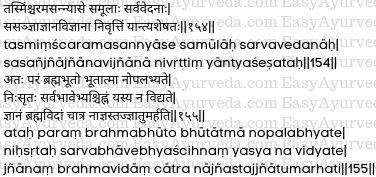
Attainment of final renunciation
As soon as the final renunciation in respect of all subsequent actions is attained, the very consciousness together with its final causes in the form of indeterminate, determinate or scriptural knowledge is completely eradicated. [154]
The state thereafter
When all kinds of pains end, when all kinds of knowledge cease to exist, and when the individual soul merges with the greater soul, there will be no existence of emphereal / individual soul. Therefore, he will not be available in any form. He will be free from all the entities (8 prakriti and 16 vikriti) and he does not even leave any indication (inspiration, expiration etc) of his Existence. This is what that well versant in the knowledge of Brhman says. It is impossible for an ignorant person to know this. [155]
Read – 40 Ways To Attain Salvation As Per Ayurveda – Nivrutti

To sum up:
In this chapter on “the various division of the Empirical Soul etc., as conducive to the understanding of the body” 23 important questions regarding the Empirical Soul have been answered by the enlightened seer. [156]
Thus ends the first chapter on “the Divisions of the Empirical Soul etc, as conducive to the understanding of the body” of the Sharira section of Agnivesha’s work as redacted by Charaka. [1]










